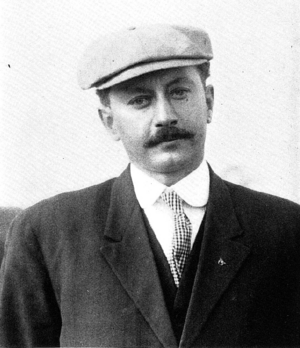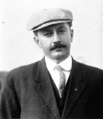Alvin Kraenzlein facts for kids

Kraenzlein in 1911
|
|||||||||||||||||||||||
| Personal information | |||||||||||||||||||||||
|---|---|---|---|---|---|---|---|---|---|---|---|---|---|---|---|---|---|---|---|---|---|---|---|
| Born | December 12, 1876 Minneapolis, Minnesota, U.S. |
||||||||||||||||||||||
| Died | January 6, 1928 (aged 51) Wilkes-Barre, Pennsylvania, U.S. |
||||||||||||||||||||||
| Occupation | Athletics competitor | ||||||||||||||||||||||
|
Medal record
|
|||||||||||||||||||||||
Alvin Christian "Al" Kraenzlein (born December 12, 1876 – died January 6, 1928) was an amazing American track-and-field athlete. People called him "the father of the modern hurdling technique." He made history at the 1900 Summer Olympics in Paris.
Alvin Kraenzlein was the very first athlete to win four individual gold medals in track and field at a single Olympic Games. As of 2016, he is still the only one to have done this! He also created a new way to run hurdles, keeping his leg straight. This helped him set two world records in hurdling. He is honored in both the Olympic Hall of Fame (1984) and the National Track and Field Hall of Fame (1974).
Contents
Alvin's Early Life and Sports Beginnings
Alvin Kraenzlein was born in Minneapolis, Minnesota. His parents, Johann Georg Kränzlein and Maria Augusta Schmidt, were from Germany. His family later moved to Milwaukee, Wisconsin.
Alvin went to East Side High School in Milwaukee. There, he started getting really good at sports. In 1895, at the Wisconsin Interscholastic Championships, he won many events. He took first place in the 100-yard dash, 120-yard high hurdles, 220-yard low hurdles, high jump, and shot put.
College Years and New Techniques
Alvin went to the University of Wisconsin to study engineering. In 1896, he continued to shine in track and field. He won the 220-yard low hurdles and the high jump. He also placed second in the 100-yard dash and shot put.
In 1897, he helped the Wisconsin team win the team title at the Intercollegiate Athletic Conference Championship. He also won the 220-yard low hurdles at the Amateur Athletic Union (AAU) championship. That same year, Kraenzlein set an indoor world record in the 300-yard low hurdles.
In 1898, a famous coach named Mike Murphy invited Alvin to the University of Pennsylvania. Alvin moved to Philadelphia and studied dentistry there, finishing in 1900.
While at the University of Pennsylvania, he became a national champion. He won five AAU titles in hurdling and long jump. He also won eight Intercollegiate Association of Amateur Athletes of America (IC4A) titles. He set world records for the 120-meter high hurdles and the 220-meter low hurdles. His 220-meter record lasted for 25 years! In 1899, he set a long jump world record of 24 feet 3.5 inches.
How Alvin Changed Hurdling
Alvin Kraenzlein was famous for his special way of running hurdles. He was one of the first to use the "straight-lead-leg" method. This means the first leg going over the hurdle stays straight and parallel to the ground. Another athlete, Arthur Croome, tried this in 1886. But Alvin perfected it and made it a popular technique. This was a huge step forward because it let athletes clear hurdles without slowing down.
Alvin Kraenzlein: An Olympic Star
In 1900, Alvin Kraenzlein was training for the Summer Olympics in England. Before the Olympics, he won the British Amateur Athletic Association Championships in London. He won both the 120-yard hurdles and the long jump. Then, he went to the 1900 Summer Olympics in Paris. There, he set a new world record in the 120-yard hurdles on a grass track.
Alvin became the most successful athlete at the 1900 Olympics. In just three days, he won four gold medals! He set new Olympic records in each event:
- 60-meters sprint (7.0 seconds)
- 110-meters high hurdles (15.4 seconds)
- 200-meters low hurdles (25.4 seconds)
- Long jump (7.185 meters or 23 feet 6.75 inches)
In the 60-meter sprint, he ran both the first race and the final in 7.0 seconds. He beat Walter Tewksbury by just a tiny bit in the final. In the long jump, Alvin won against his big rival, Meyer Prinstein, by only one centimeter! Prinstein had set his best mark in the first round. He didn't compete in the final because it was held on a Sunday. It was said they had agreed not to compete on Sunday. When Prinstein found out Alvin did show up, he was very upset.
Alvin's Life After Competing
After the 1900 Olympic Games, Alvin Kraenzlein stopped competing in late 1900. He had achieved so much, with six world records and four Olympic gold medals. He went back to Milwaukee and started working as a dentist. He also managed the Milwaukee Athletic Association.
In 1902, he married Claudine Gilman in Philadelphia. He had known her since his student days. He worked as a dentist in Philadelphia until 1906. Then, he became the track-and-field coach at Mercersburg Academy, a special school in Pennsylvania. One of his students there was Ralph Craig, who later won Olympic gold medals in 1912.
From 1910 to 1913, Alvin was the head track-and-field and football coach at the University of Michigan. In 1913, he signed a big contract with the German government. He was going to train the German Olympic track team for the 1916 Games. But this plan was canceled because World War I started.
During World War I, Alvin served in the U.S. Army. He worked as a physical training specialist. After the war, he became an assistant coach for the University of Pennsylvania track team. He also coached at summer camps and at a golf and tennis club in Cuba during the winter.
In late 1927, Alvin became sick with pleurisy, a lung problem. He passed away in early 1928 from endocarditis, a heart infection, in Wilkes-Barre, Pennsylvania.
See also
- List of multiple Olympic gold medalists at a single Games
- List of Michigan Wolverines football trainers
Images for kids


